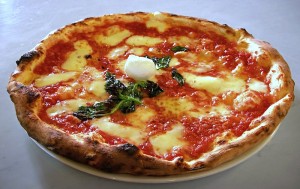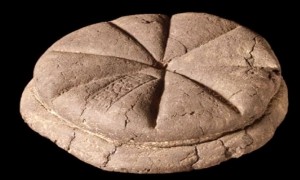When most people think of Italy, they also think of pizza.
In Naples they will tell you they invented this culinary sensation and that their pizza is still the best in the world. Pizza purists say when in Naples there are only two types you should eat: Marinara and Margherita.
The first and most basic kind of pizza is simply a flat discus of hand-kneaded high-protein wheat dough covered with garlic-infused tomato sauce, garnished with a little oregano and put in an oven for a few minutes. Legend has it that fisherman made this as a substantial early morning breakfast. That is why it is called Marinara which means sailor (or “boatman”) in Italian. I had a wonderful pizza marinara at the Pizzeria I Re di Napoli with a view across the Via Partenope towards a medieval castle with a little fishing village at its foot: the Marinari Village. Get up early and you will see the fishermen going out as the sun rises behind Vesuvius.
The second type of pizza for purists is the Margherita. Rich, creamy buffalo mozzarella is added to the simplest version to create a pizza the same three colours as the Italian flag: red tomato sauce, green basil and white cheese. Guide books will tell you this tricolore version was created in honour of Queen Margherita’s visit to Naples in the late 1800s, but a BBC researcher recently exposed this as a clever publicity ploy.
However the pizzas got their names, they are delicious. When I was in Naples a few months ago, I was astounded at how something so simple could be so good. Whether it’s something in the water – as tour guide Nina Bernardo suggests – or maybe just the magic in the air, Neapolitan pizzas really are the best.
While sitting at an outdoor table on the Via Partenope and reading Virgil’s Aeneid, I came across a passage that almost made me choke on my pizza. The bronze age hero Aeneas has been sailing the seas with other fugitives from Troy looking for a new home. When he and his men land on the shores of mainland Italy, they are nearly out of food. They only have some stale round loaves of bread to eat. They collect some “fruits of the field” (cheese? herbs? garlic?) and put these on top of the thin base.
“Hey! We’re even eating our tables!” says Ascanius, the son of Aeneas.
[Heus etiam mensas consumimus inquit Iulus. VII.116]
Immediately Aeneas remembers a prophecy given earlier in their adventures: When you arrive at a place so tired and hungry that you eat your tables, you will know you have reached your promised land. (Aeneid VII. 124-127, paraphrased)
No, they didn’t have tomatoes in the Bronze Age, and yes, Aeneas and his men ate the toppings before the base, but this passage is a lovely link between modern Italian cuisine and its ancient legends.
So next time you bite into a pizza, remember to quote the words of Aeneas’ son: Heus! Etiam mensas consumimus!
Caroline Lawrence visited Naples with Andante Travels. She is working on a retelling of an incident from Virgil’s great epic poem for Barrington Stoke.


